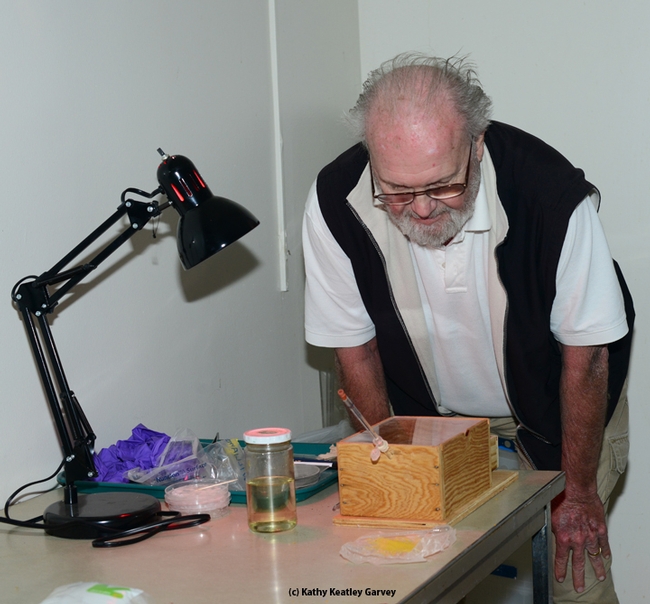- Author: Kathy Keatley Garvey
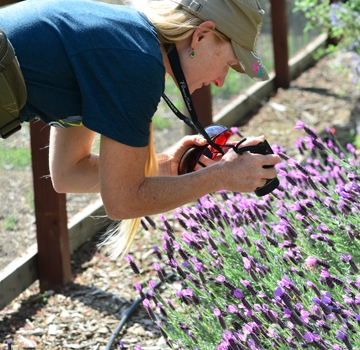
You will if you attend the Spring Festival hosted at the Loma Vista Farm, part of the Vallejo City Unified School District, on Saturday, May 16. Offering free admission, the festival will take place from 11 a.m. to 4 p.m. at 150 Rainier Ave., Vallejo.
The bumble bee nest? It's the home of a colony of yellow-faced bumble bees, Bombus vosnesenskii, a native bee species commonly found on the west coast of North America, from Baja California to Canada.
Rita LeRoy discovered the entomological prize. She's the "Farm Keeper"--that's her official title--at the Loma Vista Farm. "I've worked for the Vallejo school district at Loma Vista Farm for 25 years," she related. "I teach students about nature and nutrition through hands on farm lessons involving cooking, gardening, insect appreciation, and animal care."
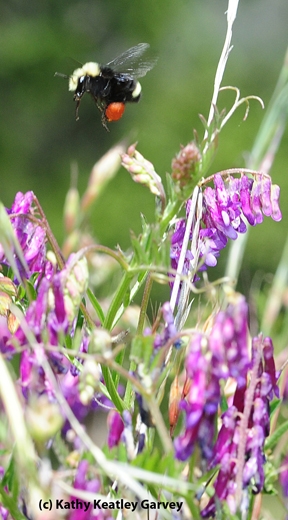
The nest is currently roped off, just waiting for two-legged folks to admire and appreciate it. It's a marvel of nature, for sure.
More on the Loma Vista Farm? Founded in 1974, it's a 5-acre outdoor classroom that provides hands-on educational activities involving plants and animals for children of all ages and abilities, according to its website. "We seek to increase students' knowledge of nature and nutrition while enhancing academic learning, ecoliteracy, and psychosocial development."
The farm offers field trips, after-school opportunities through 4-H, community service and volunteer opportunities, garden-based workshops for adults, and job training for college students, developmentally disabled young adults, and disadvantaged youth.
We first visited the Loma Vista Farm back in the 1980s as part of a 4-H activity. It was--and is--a delightful place to be. (And bees think so, too!)
Loma Vista Farm is open to the public Monday through Friday from 9 a.m. to 2:30 p.m. during the school year. It is closed on holidays and follows the Vallejo school district calendar.
And the Spring Festival? It's an opportunity for friends and families to visit the farm and participate in crafts and activities. Activities include educational information booths, animal adventures, train rides and greenhouse tours. Download flier.
In the meantime, check out the red pollen load of Bombus vosnesenskii (at left). We saw the bumble bee foraging on vetch last weekend at the Hastings Preserve, Carmel, a biological field station operated by the University of California. The Hastings Preserve was the site of a BugShot macro photography workshop taught by acclaimed insect photographers Alex Wild, John Abbott and Thomas Shahan.
And for more information on bumble bees, be sure to read the book, Bumble Bees of North America: An Identification Guide (Princeton Press), co-authored by one of our own, Robbin Thorp, native pollinator specialist and distinguished emeritus professor of entomology at UC Davis. Lead author is Paul H. Williams, and co-authors are Leif Richardson and Sheila Colla.
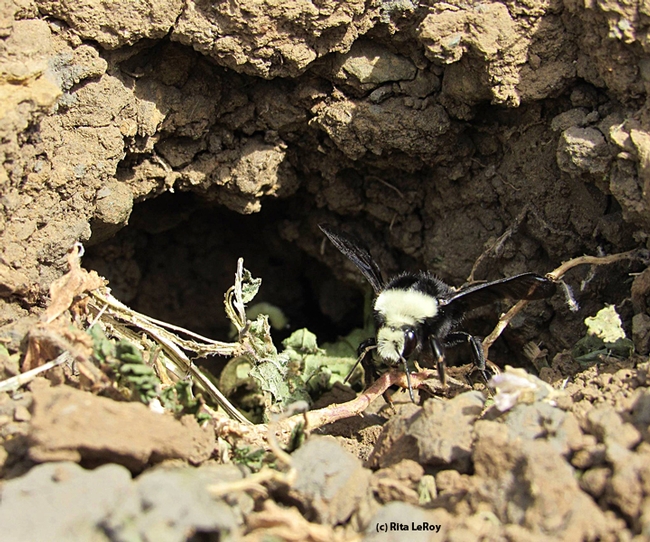
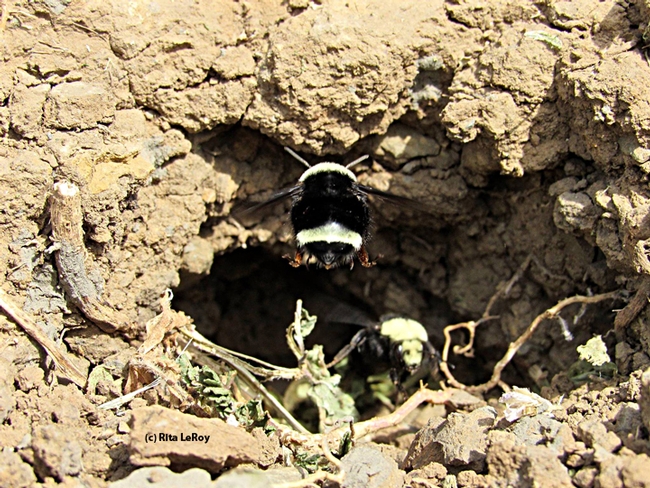
- Author: Kathy Keatley Garvey

With your camera!
If you're into pollinators, plants and photography, and want to share your work nationally, here's a new project for you.
To generate some buzz for pollinators, the Center for Food Safety (CFS) is partnering with the Wild Bee Gardens app to sponsor a national photography contest.
Bay Area native bee enthusiast Celeste Ets-Hokin, who launched the Wild Bee Gardens app (with identification assistance from consultants, including native pollinator specialist Robbin Thorp, distinguished emeritus professor of entomology at the University of California, Davis), alerted us to the contest.
It is "designed to raise awareness about the dazzling diversity of North America's native bees and other pollinators," she said, "and to engage residents from coast to coast in the vital and rewarding business of creating a continental tapestry of wild bee gardens,"
The winning photographs will be published in the Wild Bee Gardens app, and also promoted on the CFS website, Facebook and Twitter pages.
CFS, headquartered in Washington, D.C., with branch offices in San Francisco, Honolulu and Portland (Ore.) describes itself as "a national non-profit public interest and environmental advocacy organization working to protect human health and the environment by curbing the use of harmful food production technologies and by promoting organic and other forms of sustainable agriculture. CFS also educates consumers concerning the definition of organic food and products."
Judges will choose numerous winners, and each will receive a free Wild Bee Gardens app to keep, or give as a gift, "so that you can share your enthusiasm for wild bees and their gardens with your friends and families," Ets-Hokin said. Winners also will receive a pollinator swag bag from CFS.
Want to learn more about the submission guidelines and selection criteria? Access http://centerforfoodsafety-wildbees.tumblr.com . The deadline to submit photos is April 17.
If you can't identify the pollinator, not to worry. After the judges select the winners, Thorp will identify the bees. He's a co-author of California Bees and Blooms: A Guide for Gardeners and Naturalists (Heyday), along with colleagues Gordon Frankie, Rollin Coville and Barbara Ertter. Thorp also co-authored Bumble Bees of North America: an Identification Guide (Princeton University Press).
Speaking of bumble bees, they seem to be quite scarce this year. We saw our first black-tailed bumble bee (Bombus melanopygus) of the season on March 15 on Spanish lavender in Vacaville.


- Author: Kathy Keatley Garvey

For me, it's zero, zilch, nada.
They're out there, though. Talent insect photographer Allan Jones of Davis, shared some of his images that he captured this year.
Bumble bees, however, are declining throughout the world, and it would be "a frightening thought" if bumble bees were to go from declining to extinct, said native pollinator specialist Robbin Thorp, distinguished emeritus professor of entomology at the University of California, Davis.
He and fellow bumble bee authority Sheila Colla of Eastern Canada are the co-coordinators of the North American (United States and Canada) Bumble Bee Species Conservation Workgroup for the International Union for Conservation of Nature (IUCN).
Thorp and Colla are featured in a newly released Radio-Canada video on declining bumble bees.
The six-minute version was broadcast last weekend. You'll hear the news reporter speaking French and Thorp and Colla speaking English as they talk about the declining bee population:
Bee breeder-geneticist Michael "Kim" Fondrk of UC Davis, now retired, is featured in a segment on honey bee instrumental insemination:
https://docs.google.com/file/d/0ByTaUv9eMDXLR0RQRWVXUnFWU2M/edit
A one-hour show, also broadcast last weekend, and more about honey bees, is at
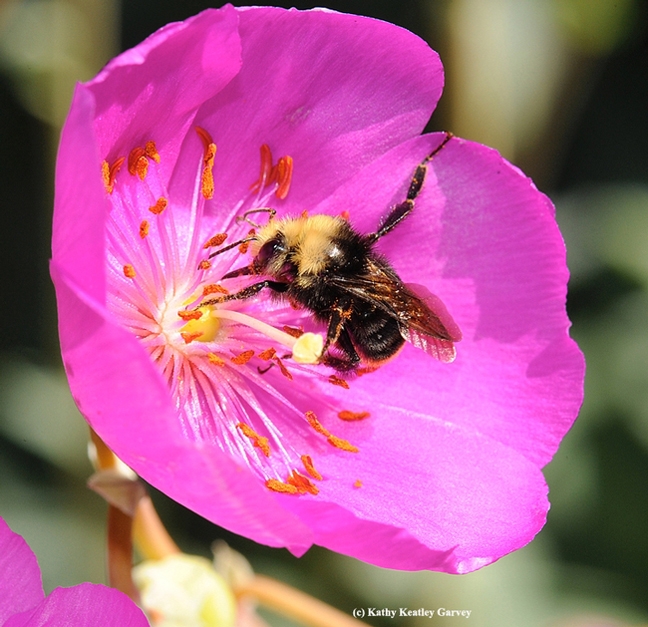
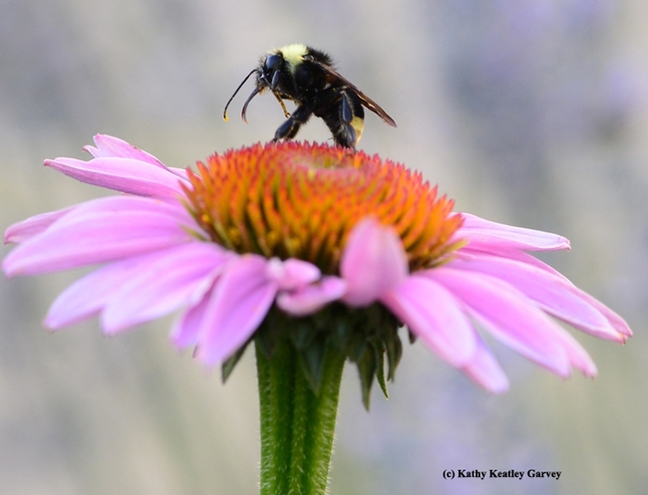


- Author: Kathy Keatley Garvey
Bumble bees and spiders don't mix, you say?
Well, they will at the Bohart Museum of Entomology's open house from 1 to 4 p.m., Saturday, July 26. The family-centered event, free and open to the public, takes place in Room 1124 of the Academic Surge building on Crocker Lane, UC Davis campus.
Actually the theme is about spiders: "Arachnids: Awesome or Awful?" There you'll see black widow spiders, jumping spiders, cellar spiders and the like. But you don't have to "like" them as you do posts on Facebook!
You can also learn about bumble bees. Native pollinator specialist Robbin Thorp, emeritus professor of entomology at UC Davis, will be one of the tour guides. Thorp co-authored the newly published Bumble Bees of North America: An Identification Guide, which is available in the Bohart gift shop. He can autograph your book and answer questions about how to attract bees to your garden.
Thorp was recently interviewed by Tom Oder of the Mother Nature Network on how to garden for bumble bees. So was Steve Buchmann, an adjunct professor in entomology and ecology at the University of Arizona.
Thorp told Mother Nature Network that some bumble bees are in very serious decline, and others are doing quite well.
So, how do you attract them to your garden? Buchmann was quoted as saying: “Gardening for bumblebees is similar to gardening for other bees and pollinators." To entice bumblebees to visit your garden, “plant mints, Salvia, Monarda, plants in the sunflower family and clovers."
Read Oder's article for more information.
And keep your eyes open for the soon-to-be-published California Bees and Blooms: A Guide for Gardeners and Naturalists, co-authored by entomologist Gordon Frankie of UC Berkeley, Thorp, and two others with UC Berkeley connections: photographer/entomologist Rollin Coville and floral curator Barbara Ertter.
As for Saturday, July 26 there won't be a vote on whether you like bumble bees or spiders better, nor will you be asked to sing "Itsy Bitsy Spider" or "Baby Bumble Bee." It promises, though, to be fun and educational. Plus, you can enjoy the live "petting zoo," featuring 24-year-old Rosie the tarantula, assorted walking sticks, and the colorful Madagascar hissing cockroaches. Yes, they hiss.
The gift shop is also popular. You can browse through the books, jewelry, t-shirts, sweatshirts, insect-themed candy, butterfly houses, and insect-collecting kits.
The Bohart Museum, directed by Lynn Kimsey, professor of entomology at UC Davis, houses nearly eight million insect specimens and is the seventh largest insect collection in North America. It is also the home of the California Insect Survey, a storehouse of insect biodiversity. Noted entomologist Richard M. Bohart (1913-2007) founded the museum.
The museum's regular hours are from 9 a.m. to noon and 1 to 5 p.m. Mondays through Thursdays. It's closed to the public on Fridays and on major holidays. Admission is free. For more information, email education and outreach coordinator Tabatha Yang at tabyang@ucdavis.edu or telephone her at (530) 752-0493.

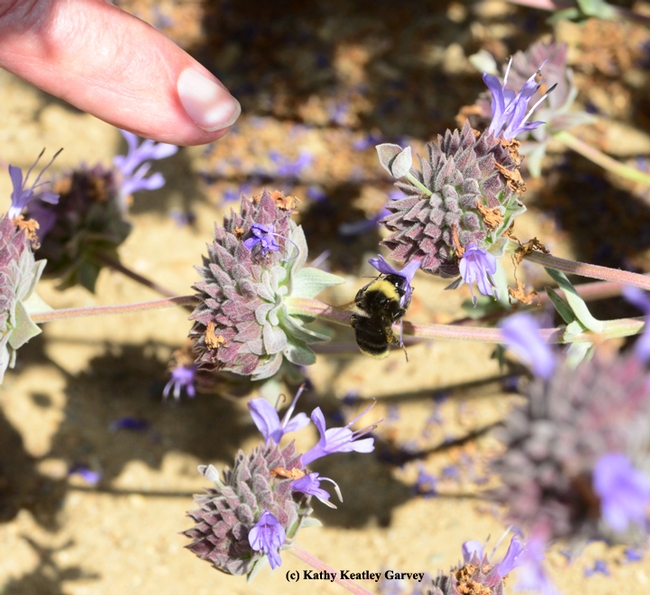
- Author: Kathy Keatley Garvey

The three queen bumble bees (Bombus melanopygus) we found buzzing around our porch light the night of Jan. 9 are still very much alive.
Who would have "thunk?"
Native pollinator specialist Robbin Thorp, emeritus professor of entomology at the University of California, Davis, is caring for them at the Harry H. Laidlaw Jr. Honey Bee Research Facility on Bee Biology Road.
Thorp, who officially retired in 1994, maintains an active research and bee monitoring/identification program based as the Laidlaw facility. He recently co-authored a book on Bumble Bees of North America: An identification Guide (Princeton University Press), to be released in March.
So yesterday photographer/artist Allan Jones of Davis and I checked out "The Lovely Ladies at the Laidlaw." Yes, they're very much alive.
But it sure was strange on Jan. 9 to see them as as night fliers, or porch-light bumble bees. I figured they were parasitized. I figured that a florid fly, Apocephalus borealis, which lays its eggs in such insects as bumble bees, wasps and honey bees, had nailed them. I figured they'd be goners within a few days.
I hope I'm wrong.
It's long been known that Apocephalus borealis infests bumble bees. However, Professor John Hafernik of San Francisco State University and his colleagues caused quite a media stir when they discovered that this fly infests honey bees as well. They published their work, "A New Threat to Honey Bees, the Parasitic Phorid Fly, Apocephalus borealis," in PLOS ONE back in January 2012. They revealed that the parasitized, disoriented honey bees (which they nicknamed "Zombies" or "ZomBees") leave their hives at night and head for the lights.
"After being parasitized by the fly, the bees abandon their hives in what is literally a flight of the living dead to congregate near lights," said Andrew Core of the Hafernik lab. 'When we observed the bees for some time—the ones that were alive—we found that they walked around in circles, often with no sense of direction."
What's next?
Fingers crossed that the three queen bumble bees aren't parasitized. Fingers crossed that they will survive. Fingers crossed that they will continue to be "The Lovely Ladies at the Laidlaw."

